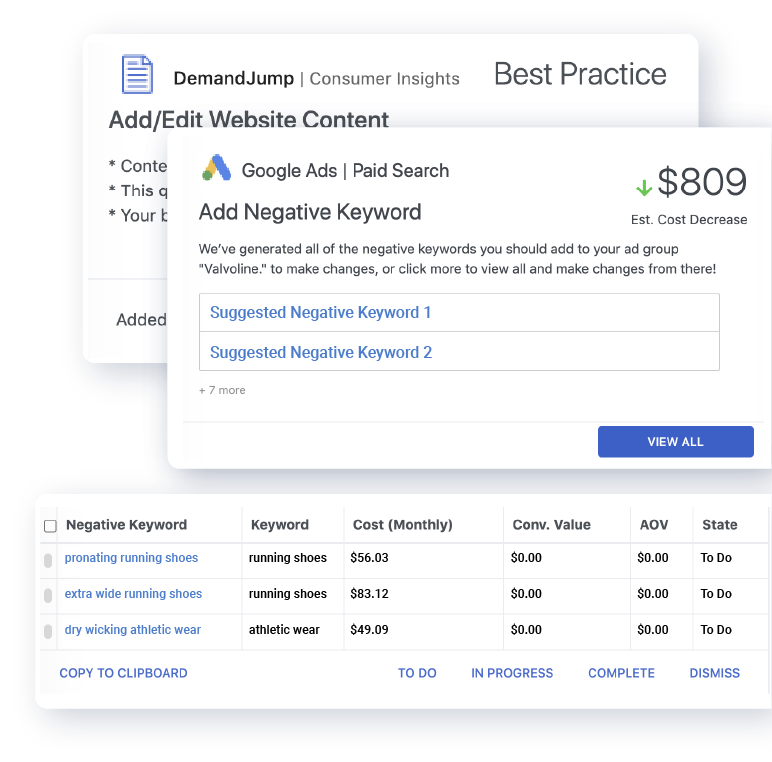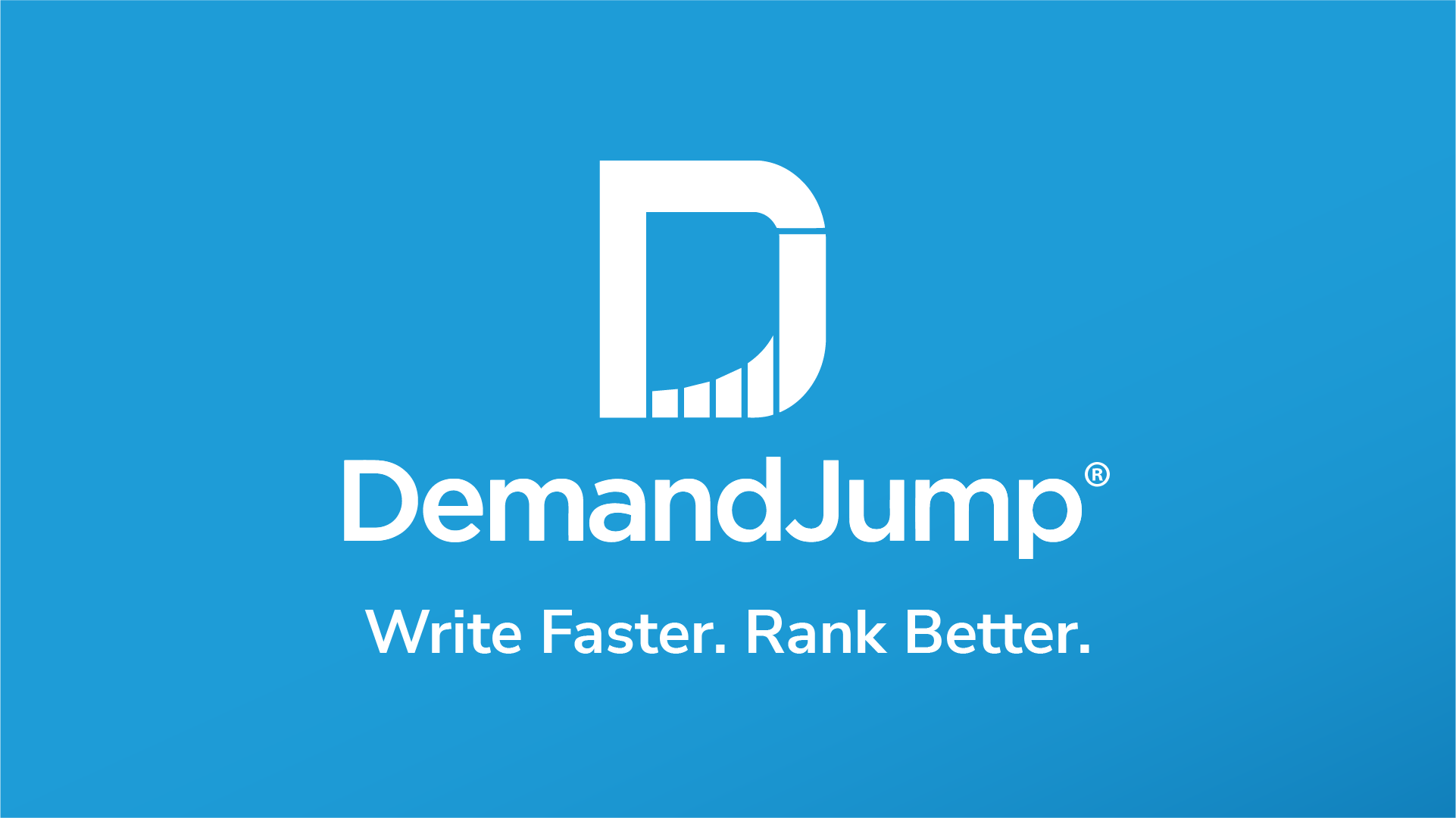Content Strategy Powered by Insights
By embracing DemandJump's approach to SEO, we have been able to increase our organic rankings within just 2 weeks of implementing recommendations. This helped us see a 22% increase in organic search month-over-month.
Robert Jacko Vice President Digital Marketing @ Homage
DemandJump has become a crucial extension of our marketing team, providing game changing insights to fuel and propel all aspects of our digital marketing efforts. The DemandJump platform is a must have, we are seriously impressed.
Tim Lavinder Director of Ecommerce @ Hotsox
We used to spend hours looking for insights in dozens of tools and reports. Now we log into one place to find out what customers are doing and how to meet them where it matters most.
Zach Roop Digital Marketing Manager @ Dometic
We use DemandJump recommendations as our digital to-do list. We love going in and seeing the recommendations and knowing what to do next.
JoLynda Wilson Marketing Director @ IWC
Trusted by Brands Around the World
How can I optimize my search marketing?
You can improve your marketing performance with the right adjustments to your keywords. Uncover blindspots in your strategy and save budget when you focus on the keywords that will increase ad relevance and landing page experience.
- Align Ad Copy to Consumer Behavior
- Get More From Your Budget
- Improve Keyword Quality Score
- Add Negative Keywords
- Add New Keywords
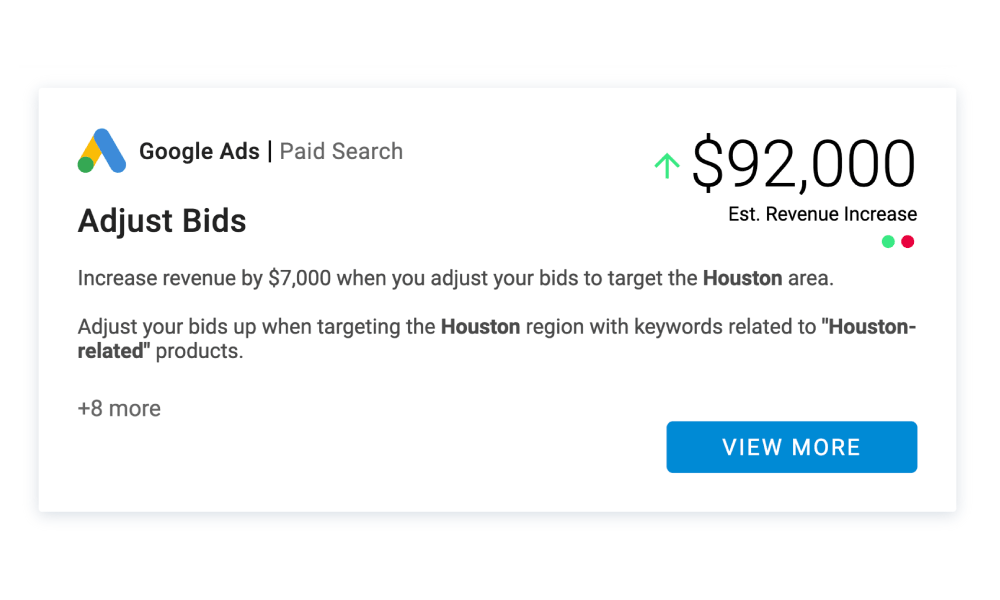
![]()
How do I increase traffic to my site and target new leads?
Increase traffic to your site by placing highly relevant ads on affiliate sites in your competitive landscape. This added exposure will help you reach new leads before your competitors do.
- Engage New Lead Gen Sources
- Targeted Display Ad Placement
- Reach New Traffic Sources
How can I rank higher on search engines organically?
You can rank higher organically when you align your keywords and content to answer the exact questions being asked by consumers. Discover which websites have content about your competitors and become an industry leader on trending topics.
- Improve Website Content
- Update Your Metadata
- Enhance Your Landing Page
- Add New Backlinks
- Create Better Content
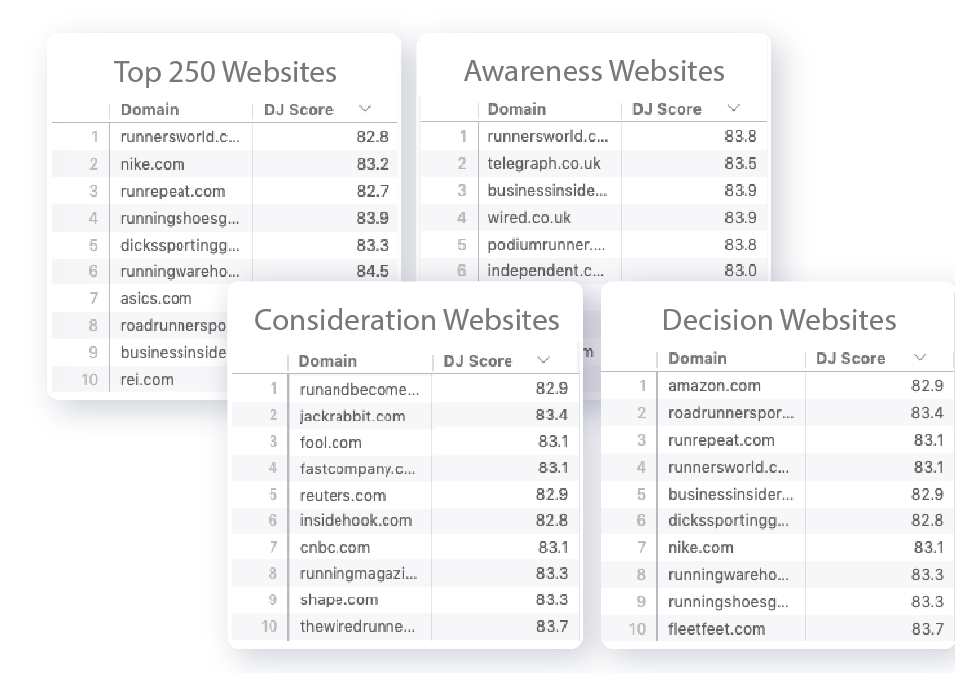
Get Free Consumer Insights Now
The term channel optimization refers to the process of using data to incrementally improve performance within your various marketing channels.
What does channel optimization really mean?
Channel optimization comes down to religiously tracking your key performance metrics from the entire funnel across all channels. In order to really optimize your channel marketing performance, you need to make sure your data provides a comprehensive cross-channel view of your overarching marketing strategy - to really get the whole story. When evaluating how you’re optimizing your marketing channels, it helps to understand how one channel's actions influence the performance in others. It always helps to visualize your website traffic as it comes from a variety of different sources.
For example, did you recently launch a facebook campaign that drives people to a certain landing page on your website? How is this traffic converting compared to advertisements you’re running on other channels?
Another key question to ask would be, “how does this Facebook or display advertising campaign directly influence the amount of organic or paid search traffic your website is getting?” Clickthrough rates on the ads your running would not be the only metric you should be tracking. Oftentimes, we see an increase in search traffic that is directly influenced to ad spend in other channels. In this case, you might underestimate the impact and performance of these ads if you don’t have a comprehensive view.
Channel Optimization Recommendation
Channel optimization is useless unless it ties directly back to your bottom line and improves the ROI of your marketing initiatives. Your best benchmark of success for your channel optimization efforts is ROI because the whole concept of optimization is centralized around increasing revenue while decreasing costs. If you are adding on marketing initiatives and seeing new revenue coming in the door - that’s great. But is this a more efficient means of bringing in new customers than you’ve tried in the past? If not, it’s best to use your analytics tools to understand why this is.
If you’re driving a lot of traffic to your site but no one is converting, take a deeper look into why this is happening? What is your audience doing when they arrive on your site? If you just added a new source of site traffic and this is happening, it might be that the audience that you’ve reached in that new source is unqualified to buy from you, and you may want to reevaluate where you place your ads, or what affiliate websites you are working with.
Examples of Channel Optimization
DemandJump’s channel optimization product leverages artificial intelligence to detect tactics for optimizing your marketing channels. Some of these channel optimization strategies include:
Display Advertising Optimization
The DemandJump platform helps you optimize your programmatic advertising performance by analyzing the traffic going to your competitors sites, discovering what’s working for their display advertisements, and offering up suggestions for your display campaigns. Our platform surfaces these in the form of a card in your recommendation center and offers clear instructions of what to do with this information - turning data into actionable insights automatically.
In the channel optimization example below, you’ll see the recommendation is for a new “Display Placement Opportunity”. Here, our platform is recommending that the customer add specific websites to their ad placements in order to draw in the highly qualified traffic that their competitors are getting.
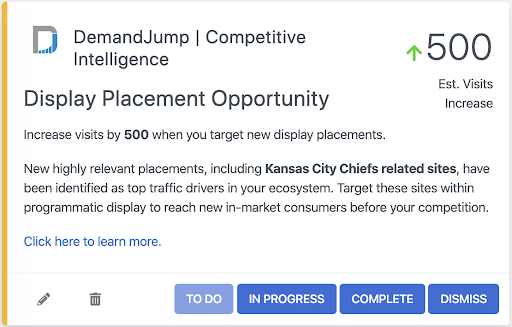
These placements include more relevant websites to their brand than the ones they’re currently serving advertisements on, so these new placements are estimated to improve their display performance by bringing at least 500 new qualified visitors to their website.
Content Optimization
DemandJump’s content optimization recommendations analyze consumer behavior to provide actionable recommendations to improve your content performance in a couple ways. One way is by analyzing the search and online behavior of your target audience. By surfacing what your target audience cares about, and comparing this to the content you currently have published, the DemandJump platform makes actionable recommendations regarding what topics you should cover in the future with your blogs in order to increase qualified traffic to your website. With these recommendations, you can fully optimize your content marketing strategy.
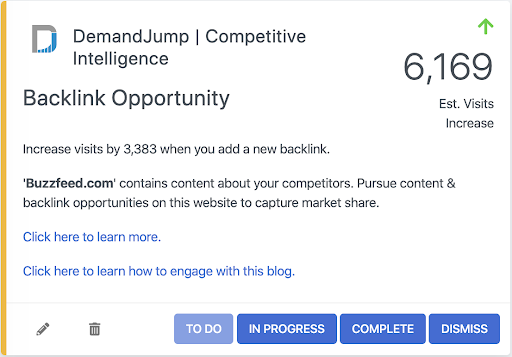
Not only does DemandJump’s channel optimization product share new content ideas backed by data, it uncovers what websites your target audience visits, and therefore which sites you should seek backlinks from. These backlinks will help your content rank better in search engines, and will also bring a steady flow of qualified traffic from websites our product has analyzed to be in-line with your marketing strategy.
Search Channel Optimization
The channel optimization product also analyzes your paid search marketing campaigns to offer search channel optimization automatically in real time. A few of these recommendations the product makes to optimize your paid search campaigns include: adjusting your bids, creating more ads, targeting new keywords, and improving ad relevance or landing page experience to drive your quality score up.
Adjust Bids
The product might recommend adjusting bids in certain geographic regions or for certain keywords based on trends the system analyzes daily. If the DemandJump platform sees an uptick in searches coming from certain geographic locations where you do business or from certain key terms, these might be an opportunity for you to capture new business in real time. By increasing your bids on these newfound opportunities, you’ll be able to rest assured knowing that your search campaigns are fully optimized to bring in new business.
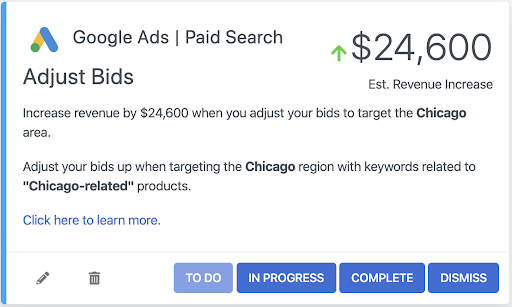
Another component of DemandJump’s channel optimization product is its incorporation of search marketing best practices to inform your channel optimization tactics.
Create More Ads
One way to save money with your paid search ads is to make them more targeted on specific keywords instead of including a variety of keywords in one campaign. The inclusion of too many keywords in your campaigns causes your ads to show up in less relevant searches, where you’re less likely to draw in new business. And when you bid on keywords that aren’t super relevant to the contents of your ads, your quality score goes down, subsequently driving your cost up.
So, one of the recommendations our product will make is to increase the number of ads you're running to decrease this ad inefficiency. Creating more ad campaigns targeting fewer keywords optimizes your search performance by allowing you to meet more customers in an even more relevant context with ads that are more helpful to their current buyer journey.
Add New Keywords
Alongside these search recommendations, our product will also recommend adding specific keywords to your ads to improve performance. It does this by analyzing the successes of your competitors as well as analyzing the online behavior of your target audience.
If your competitor is getting a lot of traffic from a term you would also benefit from bidding on, you’ll see a card to incorporate these keywords into your campaigns and ads.
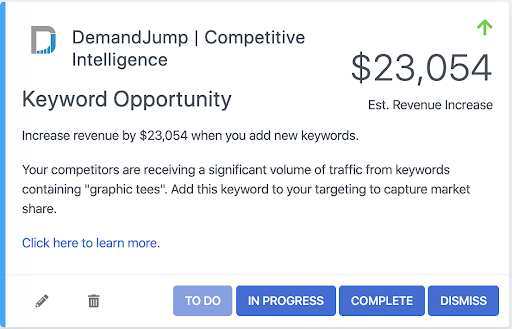
In addition to seeing what keywords you should be bidding on to improve your search performance, you’ll also be given an estimate of the impact this new change will have on your business. In this case, the customer will increase annual revenue by $23,000 if they start bidding on these new keywords.
These recommendations utilize advanced mathematics and analysis of the impact these changes are having on your competitors to give you a data-backed recommendation for your marketing team’s next-steps.
When you see these cards in your recommendation engine, effective marketing becomes as simple as evaluating which change will yield the biggest result.
Improve Quality Score
As mentioned above, these channel optimization recommendations are based on Google’s best practices. Our software leverages knowledge of these best practices and analyzes your adherence, or lack-there-of, to these guidelines. Because having a high quality score is directly related to decreasing the cost per click and cost per conversion of your search campaigns, when our platform notices you have a low quality score, it offers specific recommendations to remedy that.
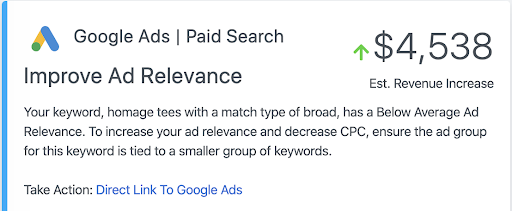
In the example above, you’ll notice the recommendation is to improve ad relevance. This is because having a high ad relevance drives up your overall ad quality score, decreasing your CPCs. To explain this, when your ad relevance is high, that means that you’ve aligned the contents of your ads to the keywords your bidding on, and the search queries consumers are entering into google and other search engines.
Think about this from the consumer’s perspective. When they search for something, they know what they want. They tend to click on the thing that is most aligned with the search they entered. So if they’re looking for “red cool new tennis shoes” and they see an ad that reads “red cool new tennis shoes” that ad will perform better. You’ll need to run less of them to get the same desired result in turn.
Multi-channel Optimization
Terms like multi-channel optimization have been popular for the last decade. An important component of multichannel optimization includes creating a seamless experience for customers as they interact with your brand across multiple channels. This means aligning messaging across marketing channels to create a consistent brand experience, regardless of where the customer sees you.
You want your customer to have an identical experience, no matter where they find your product. In a brick and mortar store, on your website, or through a social media platform, their experience should be reliable.
Channels have become increasingly important in the digital age, if only because there are so many of them. You reach customers through your website, any shopping cart or sales locations, social media, text message, email campaigns and newsletters, and don't forget any review sites where your customers might post about their experiences. You can also reach your customer through third party sites, such as guest posting on an industry leader's blog.
Your marketing channels might include print ads, television and radio commercials, and direct mailing. You might also attend conferences and trade shows or do guest speaking and lectures. The list of possible ways to reach your audience will depend on the type of business you are in by industry, product or service. In virtually all businesses, the marketing efforts include more than one channel, which makes channel optimization a priority for your digital marketing strategy.
Digital Marketing and the Use of Channels
Digital marketing is essentially any and all marketing efforts you use online, but it doesn't stop there. The truth is that the online experience has become so much a part of people's everyday life that your marketing endeavors need to be uniform everywhere. For instance, many companies use SMS marketing, which is not technically online, it's through text messaging. However, most of these ads will include links to a website or spur further action from the customer. These campaigns would be included in your digital marketing strategy.
Your digital marketing framework should include all the channels that you use in your digital marketing campaigns, as well as the channels that inform your digital marketing efforts. So if the channel feeds into a digital channel, it should be counted in your framework. The basis for your digital framework should take into consideration the most important function of your marketing efforts. This might be to increase visitors to your website. By itself, increasing visitors increases your reach but it doesn't necessarily equate to increased conversion. For increased conversion, you need to target the right visitors. This might mean targeting customers who will spend a great deal or it might simply mean targeting more customers who will convert to some form of sale, depending on the type of business.
If you're selling tiered plans of service, attracting ten customers who convert to a service that's valued at $30 is not as advantageous as attracting one customer who converts to a service valued in the thousands. Your strategy here will depend on whether you're aiming for a wide audience or a focused type of client.
A digital marketing example might be any of the online campaigns you launch on any channel. Your strategy will organize all of your channel engagement efforts so that they build off and inform each other. In this way, your audience can organically connect with your brand on all of their various digital platforms. For example, your customer might visit your website based on an article they read. They're not yet convinced to purchase, but they see your paid ad again in their social media feeds. Then they run across a review about your products on the third party site. It's not the one contact that converted that customer. It will often be a combination of the different connections and the overall impression they've formed through multiple experiences.
What Are Digital Marketing Channels?
The term digital marketing channels refers to the various digital avenues that your customer may engage with your brand, such as through email, search and display advertising, affiliate marketing, or social media.
Traditional advertising channels often included advertisements in newspapers and on billboards. They might include point of sale ads, such as the displays you would see at a checkout line. They also might include direct mail ads and telemarketer phone calls. For larger companies, these ads might include television commercials and radio ads. For print ads, there would usually be a set fee determined by the distribution size or the size of the ad. For radio and television advertising, the fee would be associated with the number of times the ad was played on air and during which broadcasts. For instance, a commercial spot during the big game might be expensive but running your commercial during rerun broadcasting would be less so.
Traditional marketing initiatives had several distribution methods. These might include direct sales, distributors, and retailers. The manufacturer of the product has a few choices with regard to how they sell and market that product. When your product is placed in retail locations, the retailer will help you sell the product but often the print ads and sales materials come from the manufacturer. For instance, if you went to a bar, you'd notice signs for different alcohol and beverages around the establishment. These are provided to the bar from their distributors as a way to help sell products.
For the most part, these traditional modes of advertising did reap results, and they are still in use today, though they are far eclipsed by digital marketing efforts. Many digital marketing channels can be used to great effect with a much lower investment. Small companies can even take on their own marketing initiatives to help grow their own businesses.
Digital marketing channels that are widely in use today include email campaigns, SEO, social media marketing, pay per click paid advertising, banner ads, content marketing, and affiliate marketing. Those are the channels you might be using but there are other channels online that your brand should also pay attention to, such as third party review sites and eCommerce sites that may carry your products. Digital marketing encompasses numerous channels that all need to be incorporated with any traditional advertising strategies you may be using.
Channel Optimization Strategy
Your digital marketing strategy should include channel optimization. Each of the digital channels that you use will need to be analyzed so that you can determine the ROI from those campaigns. Using the analytics and comparing your performance across multiple channels can inform how you spend time and money in your digital marketing efforts. It will also inform the changes you can make to increase profits and improve performance.
If you need a digital marketing strategy example, take any focused campaign that uses online channels to reach the consumer. Some campaigns involve more than one discipline or channel. For example, email campaigns often link to landing pages that push the consumer further down the funnel. They may also promote online webinars and other activities that are part of a separate channel. Ideally your digital strategy should not only include all the channels you're using but it should help you organize your efforts so that the customer gets the same seamless experience, no matter where they reach your brand. For this example, understanding consumer behavior is very important to marketing effectiveness.
Your digital strategy serves as a sort of business plan for your online marketing endeavors. It should be developed with set goals and benchmarks in place so that you can review the latest analytics and adjust your campaigns accordingly.
Digital Transformation Strategy
You'll hear the term digital transformation companies often, but what does digital transformation mean? It depends on the industry. Technology is fast moving and each industry has a current need to keep moving toward better software and technological solutions.
For marketing, a digital transformation strategy is about the use of digital channels for marketing campaigns and the ability to organize a multi-channel approach that analyzes and uses all the data to develop more tailored campaigns that span all the channels. Ideally this form of strategy bridges all of the different contact points for your customers so that they always get the sense of your brand, no matter where they reach you.
The four main types of Digital transformation examples, including organizational or business changes, changes in the business processes, new business domains, and the specific model of doing business. Transformation is an all encompassing word and that's exactly what technology has brought to the table. While this might seem out of the realm of possibility for companies that don't specialize in technology, that's a false assumption. The reality is that there are many avenues to contract with professionals who can help with these farther reaching transformations.
The reality is that businesses can only stay competitive today if they do embrace digital transformation. There's no way to compete with companies that are using AI and other methods to better service customers unless you're also using similar tools to aid in the process.
Marketing Campaign Optimization
Channel optimization in marketing means to use all of your various channels in conjunction. That is to say that all of your digital marketing efforts should be organized so that they work together in order to give the customer the best experience no matter where they reach your brand. There are a number of optimization techniques and strategies which can help move your campaigns further and help each campaign inform other possible touch points.
For example, you might host a contest or event on your website or blog platform. In order to promote that event, you may launch campaigns through paid advertising and social media posts. Your followers may also share your posts. The actual content works as an advertisement for your brand or maybe the launch of a new product. All of the subsequent mentions and marketing efforts also tie into that first publicity event, but they all work together to relay the same message and amplify your reach. That is optimizing your digital marketing strategy.
Another aspect to digital marketing is in process optimization. Your campaigns have many moving parts but current tools allow you to automate processes in order to reap better results with less effort.
Search Engine Optimization Techniques
You can't talk about channel optimization without discussing SEO. Search engine optimization techniques are used to help your content be visible and accessible via search engines. You can take a search engine optimization course to help you master the nuances of this aspect of digital marketing, but it does constantly change. The best mode of staying current on SEO practices is to continually update your knowledge and education. Remember, too, to double check the date on any tutorial or blog post because marketing and SEO content quickly changes. Information that was relatively cutting edge a few years ago is not longer accurate, in some cases.
Search engine optimization is more than simple keywords, though that's an important aspect. SEO is much wider and it basically helps you to make sure that the searchers get what they need when they find your site. Google and other search engines are most concerned about the searcher's experience. To rank highly in search engines, you need to provide valuable content that matches their search terms. This means that you'll need to develop good content, but you'll also need to research the best search terms for your audience. There are more advanced aspects of SEO, as well. Tagging pages and posts and using good descriptions for the search engine are all part of your SEO strategy.
The basic idea is to make sure that your content all matches the search terms so that the people who find your site through search are in your ideal market. SEO terms that you might use for a local customer currently looking for HVAC repair would be completely different from the search terms you might use for people seeking to learn the trade of HVAC. That's a simplistic example but the way that you use SEO terms and page descriptions should be as accurate as possible to help in your ranking and target the right audience for conversion.
Your digital marketing strategy is likely the bulk of your overall marketing plan. Some companies use their digital marketing strategy as their entire marketing outreach. In today's world, it's very difficult to grow a business without an online presence of some sort. Using multiple channels helps you to extend your reach and amplify your message.
Resources
Channel Optimization
Consumer Behavior
Consumer Insights
Consumer Insights and Analytics
Competitor Analysis Tools
Content Marketing
Content Strategy
Cross-Channel Analytics
Customer Insight Research Techniques
Customer Journey Map
Market Intelligence
Marketing Analytics Techniques
Market Research
Marketing Attribution
Opportunities of Internet Marketing
Types of Consumer Insights


